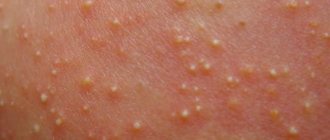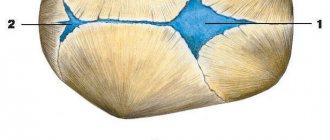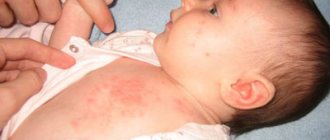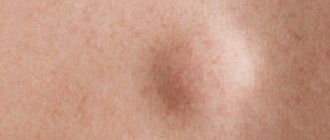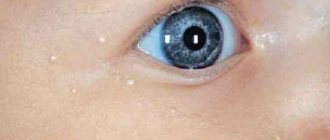November 15, 2016
Averyanova Sveta
Conjunctivitis in a newborn is a very common disease. There are quite a few reasons for the appearance of this pathology, and only a doctor can find out why this disease arose and how to treat conjunctivitis in newborns.
The condition of newborn babies should be monitored extremely carefully, since complications after conjunctivitis can cause severe damage to the health of children.
Conjunctivitis is an inflammation of the eye mucosa, which is often caused by adenoviruses or pathogenic bacteria.
In newborn babies, conjunctivitis occurs mainly due to obstruction of the channel through which tears come out.
Other causes of this disease in newborns do not differ from the reasons why it occurs in adults:
- viruses, dust, microbes penetrate the mucous membrane;
- allergies to medications;
- animal hair;
- flower pollen;
- damage from a bacterial infection.
Newborns do not have tears at first, so various discharges from the eyes should certainly worry mom and dad.
As soon as the first signs of conjunctivitis begin to appear, you should go to see a doctor, so only the doctor will be able to establish a diagnosis and prescribe the correct treatment for your baby.
The following types of disease are distinguished:
- Viral. With this type of disease, the baby begins to be afraid of light, and purulent discharge comes from the eyes. As a rule, this type of conjunctivitis is a complication after a cold. Mainly one eye suffers.
- Bacterial.
With this type of disease, strong mucous discharge from the eyes is observed. This disease is more difficult to treat because in this case two eyes are affected. - Allergic. This type of conjunctivitis often appears in spring and summer. The cause is house dust, flower pollen. This disease can be easily recognized due to swollen eyelids. The eyes don't turn red.
What it is
Conjunctivitis is an inflammation of the conjunctiva.
Young parents sometimes do not take this disease seriously and try to cure it on their own, without consulting a doctor, believing that it is an inflammation of the lacrimal sac. This is very dangerous, since the baby’s eyes can begin to fester, and there is a high probability of complications on the cornea.
Types of conjunctivitis:
- Bacterial (purulent). Its appearance is provoked by staphylococci, streptococci, E. coli, gonococci or Pseudomonas aeruginosa. Bacterial conjunctivitis can develop under the influence of one pathogen or several at once.
- Viral. In this case, the causative agent is the herpes virus. This type of conjunctivitis lasts a long time, usually affecting only one eye. Blisters appear on the eyelids.
- Chlamydial. Conjunctivitis caused by chlamydia can affect one eye or both. Its acute manifestation with abundant pus usually occurs on the fourteenth day after the birth of the child. If the baby is premature, there is a risk of developing chlamydial conjunctivitis on the fourth day.
- Allergic. It can occur as a reaction of the child’s body to any allergen. Allergic conjunctivitis occurs painfully in three stages: acute, subacute, chronic.
- Autoimmune. Such conjunctivitis can be an independent disease or occur against the background of an acute respiratory viral infection. The conjunctiva becomes red and swollen, and swelling may also appear on the eyelids. The child reacts sharply to light, tears flow from his eyes. Small blisters may form in the lower part of the conjunctiva.
This material will tell you how to treat a pathology such as dacryocystitis.
Types of conjunctivitis
How to instill drops
- It is necessary to use only a pipette with rounded ends so as not to injure the eyes.
- If the child is 2 months old, he needs to be placed on a flat surface (without a pillow), slightly pull down the lower eyelid and drip the product there, the remains of which should be wiped with a sterile napkin.
- How to treat? If the child does not like this procedure and closes his eyes, do not worry: drop the product into the area where the lower and upper eyelids meet and it will definitely get into the eye.
- Never use a cold product: warm it up in warm water or in your hand first, otherwise your child may become irritated.
- Never use products that have expired.
Causes
Infants can get conjunctivitis if they follow all the rules of visual hygiene and more, even if the environment is completely sterile. Conjunctivitis can occur for various reasons. Its course depends on the nature of the pathogen.
The most common causes of conjunctivitis in newborns are:
- Reduced immunity;
- Transfer of bacteria from the mother's body;
- Infection through the birth canal with chlamydia or gonorrhea;
- The mother has genital or oral herpes;
- Poor hygiene;
- Getting debris or foreign objects into the eye.
The health of the child directly depends on the health of the mother. A woman should think about cleanliness in advance so that when passing through the birth canal the child does not catch any infection.
Types of conjunctivitis in newborns
There are two types of this disease, based on the cause of its occurrence.
It is very important to know which one you are dealing with in order to begin proper treatment. So, eye conjunctivitis in newborns can be:
- Bacterial;
- Viral.
Bacterial conjunctivitis is also divided into:
- staphylococcal;
- pneumococcal;
- gonococcal;
- chlamydial.
Bacterial conjunctivitis is also called purulent; its main difference from viral conjunctivitis is that only one eye of the newborn is affected. In this case, thick purulent discharge is observed, which can especially frighten you. However, treatment of this particular type of conjunctivitis is easier and faster, although the disease is quite severe. But the risk of complications for the newborn is minimal.
Viral conjunctivitis affects both eyes of a newborn in turn; it is usually easier to tolerate
However, it is very important here how quickly you started treatment, because the viruses that caused the disease can penetrate the baby’s body and disrupt the functioning of internal organs that are not fully formed. And then simple conjunctivitis can threaten with quite serious complications in the future
That is why, if a newborn is overtaken by conjunctivitis, treatment should be as fast and effective as possible.
Symptoms
Conjunctivitis in infants is quite easy to identify. They are identical to the symptoms of the disease in adults. However, it is worth noting that babies react differently to conjunctivitis. They begin to cry often, become capricious, lose calm, sleep poorly, and become lethargic.
In most cases, infant conjunctivitis is caused by viruses, bacteria or allergens.
Main symptoms:
- The eyes turn red, the eyelids and conjunctiva swell.
- There is a fear of light, profuse lacrimation;
- Yellow crusts form on the eyelids;
- Pus is discharged from the eyes;
- The child eats poorly and does not sleep.
If pus is released from the eyes, then conjunctivitis is viral in nature. If there is no pus, but the eyes are red and irritated, then conjunctivitis may be viral or allergic.
Read the reasons for excessive tearing from one eye here.
Diagnostics
diagnose conjunctivitis in infants. The clinical picture of the disease does not allow us to accurately determine the cause, so a smear or scraping is made from the surface of the conjunctiva. This biological material is stained and examined under a microscope, or culture is done, which is then sent for laboratory testing of microflora. They also determine the presence of sensitivity or resistance to various antibiotics.
The results of laboratory diagnostics influence the choice of treatment method for conjunctivitis.
Additional methods for diagnosing infant conjunctivitis are aimed at detecting antibodies in the blood that fight the causative agent of the disease.
Treatment
Treatment of conjunctivitis caused by bacteria in children must be carried out in several stages:
- The first step is to remove conjunctival discharge from the peephole. This is done by rinsing with a disinfectant solution.
- After this, you need to drip an anesthetic into your eyes. It will eliminate eyelid compression syndrome and fear of light.
- At the final stage, drops or ointments with an antibacterial effect are used.
This material will tell you the specifics of using antibacterial drops.
Eye drops need to be dripped seven to eight times a day for six days, after which five to six times for three to four days, then two to three times will be enough until recovery. As for ointments, they must be applied two to three times a day to the inner surface of the eyelids.
Only the doctor decides in what conditions to carry out treatment (at home or in the hospital). It all depends on the type of disease, its severity, the age of the baby, and so on.
To remove pus from your eyes, you need to wash them as often as possible. To do this, it is recommended to use furatsilin or a solution of potassium permanganate. You need to rinse your eyelids using a rubber bulb. In the intervals between washings, drops are added every two to three hours, and ointment is applied overnight.
- For the treatment of bacterial conjunctivitis, Albucid, Levomycetin eye drops and Tetracycline ointment with antibiotics are usually prescribed.
- Viral conjunctivitis caused by herpes is treated with Acyclovir ointment, Trifluridine.
- Antihistamines and antiallergic drugs (Lecrolin, Cromohexal) are prescribed for the treatment of allergic conjunctivitis.
A brief overview of antiallergic eye medications in this article.
Treatment of adenoviral conjunctivitis
Complications
Conjunctivitis leads to decreased immunity, which in turn affects the child’s susceptibility to colds.
Colds are a factor that provokes the appearance of secondary conjunctivitis.
Experts say that the most dangerous complication that conjunctivitis can lead to is damage to the inner layers of the eyes. It can cause vision loss and cannot be cured. It should be remembered that conjunctivitis can impair the baby’s vision and also cause lung diseases. In extreme cases, laser vision correction will have to be used.
Prevention
Conjunctivitis, as is known, is transmitted by airborne droplets, so the main sources are air, the hands of parents or doctors, child care items, and eye treatment solutions.
Prevention involves a number of activities that are carried out in maternity hospitals, antenatal clinics and pediatrician appointments. The activities are aimed at timely detection and treatment of infections in pregnant women, sterilization of the birth canal and preventive treatment of the child’s eyes.
Prevention
Prevention is necessary as one of the points of therapeutic therapy. Namely:
- Maintain hygiene. In the first months, it is necessary to thoroughly wash the baby's eyes.
- Strengthen immunity. We are not talking about using some kind of vitamin complexes, which are too early to give to such a small organism. And air baths, maintaining fresh air and normal temperature in the room will just help the baby get a little stronger.
- Regular wet cleaning of the apartment will protect your child from allergies.
Conjunctivitis is one of the eye diseases that also requires timely treatment. That is why you should not let the disease progress, and even if the symptoms have already passed, it is important to show the baby to a specialist to analyze his visual functions and to reassure himself that the baby’s health is no longer in danger.
LiveJournal

